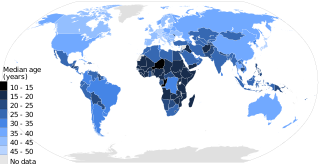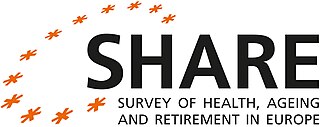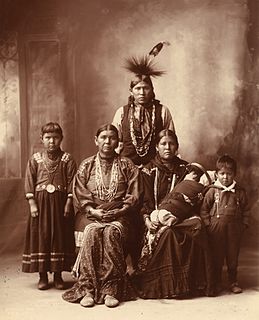Related Research Articles

Statistics Canada conducts a country-wide census that collects demographic data every five years on the first and sixth year of each decade. The 2021 Canadian Census enumerated a total population of 36,991,981, an increase of around 5.2 percent over the 2016 figure. Between 2011 and May 2016, Canada's population grew by 1.7 million people, with immigrants accounting for two-thirds of the increase. Between 1990 and 2008, the population increased by 5.6 million, equivalent to 20.4 percent overall growth. The main driver of population growth is immigration and, to a lesser extent, natural growth.

Jordan has a population of around 11 million inhabitants as of 2021. Jordanians are the citizens of Jordan. Some 95% percent of Jordanians are Arabs, while the remaining 5% are other ethnic minorities. Around 2.9 million were non-citizens, a figure including refugees, legal and illegal immigrants. Jordan's annual population growth rate stood at 2.05% in 2017, with an average of three children per woman. There were 1,977,534 households in Jordan in 2015, with an average of 4.8 persons per household.

This article is about the demographic features of the population of Tanzania, including population density, ethnicity, education level, health of the populace, economic status, religious affiliations, and other aspects of the population.
Cohabitation is an arrangement where people who are not married, usually couples, live together. They are often involved in a romantic or sexually intimate relationship on a long-term or permanent basis. Such arrangements have become increasingly common in Western countries since the late 20th century, being led by changing social views, especially regarding marriage, gender roles and religion.

The total fertility rate (TFR) of a population is the average number of children that would be born to a woman over her lifetime if:
- she were to experience the exact current age-specific fertility rates (ASFRs) through her lifetime
- she were to live from birth until the end of her reproductive life.

Population ageing is an increasing median age in a population because of declining fertility rates and rising life expectancy. Most countries have rising life expectancy and an ageing population, trends that emerged first in developed countries but are now seen in virtually all developing countries. That is the case for every country in the world except the 18 countries designated as "demographic outliers" by the United Nations. The aged population is currently at its highest level in human history. The UN predicts the rate of population ageing in the 21st century will exceed that of the previous century. The number of people aged 60 years and over has tripled since 1950 and reached 600 million in 2000 and surpassed 700 million in 2006. It is projected that the combined senior and geriatric population will reach 2.1 billion by 2050. Countries vary significantly in terms of the degree and pace of ageing, and the UN expects populations that began ageing later will have less time to adapt to its implications.
Listed here are the ethnic groups of Canadian residents as self-identified in the 2016 census in which approximately 35,151,000 census forms were completed). The relevant census question asked for "the ethnic or cultural origins" of the respondent's ancestors and not the respondents themselves.
The General Social Survey (GSS) is a sociological survey created and regularly collected since 1972 by the National Opinion Research Center at the University of Chicago. It is funded by the National Science Foundation. The GSS collects information and keeps a historical record of the concerns, experiences, attitudes, and practices of residents of the United States.
The Multiple Indicator Cluster Surveys (MICS) are household surveys implemented by countries under the programme developed by the United Nations Children's Fund to provide internationally comparable, statistically rigorous data on the situation of children and women. The first round of surveys (MICS1) was carried out in over 60 countries in mainly 1995 and 1996 in response to the World Summit for Children and measurement of the mid-decade progress. A second round (MICS2) in 2000 increased the depth of the survey, allowing monitoring of a larger number of globally agreed indicators. A third round (MICS3) started in 2006 and aimed at producing data measuring progress also toward the Millennium Development Goals (MDGs), A World Fit for Children, and other major relevant international commitments. The fourth round, launched in 2009, aimed at most data collection conducted in 2010, but in reality most MICS4s were implemented in 2011 and even into 2012 and 2013. This represented a scale-up of frequency of MICS from UNICEF, now offering the survey programme on a three-year cycle. The fifth round, launched in 2012, was aimed at offering countries the tools to do the final MDG data collection.

The middle of the 20th century was marked by a significant and persistent increase in fertility rates in many countries of the world, especially in the Western world. The term baby boom is often used to refer to this particular boom, generally considered to have started immediately after World War II, although some demographers place it earlier or during the war. This terminology led to those born during this baby boom being nicknamed the baby boomer generation.

The Survey of Health, Ageing and Retirement in Europe (SHARE) is a multidisciplinary and cross-national panel database of micro data on health, socio-economic status and social and family networks. In seven survey waves to date, SHARE has conducted approximately 380,000 interviews with about 140,000 individuals aged 50 and over. The survey covers 28 European countries and Israel.

Family is a group of people related either by consanguinity or affinity. The purpose of the family is to maintain the well-being of its members and of society. Ideally, families offer predictability, structure, and safety as members mature and learn to participate in the community. Historically, most human societies use family as the primary locus of attachment, nurturance, and socialization.

This is a list of the annual prevalence of cannabis use by country as a percentage of the population aged 15–64. The indicator is an "annual prevalence" rate which is the percentage of the youth and adult population who have consumed cannabis at least once in the past survey year.

In research of human subjects, a survey is a list of questions aimed for extracting specific data from a particular group of people. Surveys may be conducted by phone, mail, via the internet, and also at street corners or in malls. Surveys are used to gather or gain knowledge in fields such as social research and demography.
The Study on global AGEing and adult health (SAGE) is run by the World Health Organization. An objective for SAGE is to compile comprehensive longitudinal data on the health and well-being of adult populations and the ageing process across different countries, through primary data collection, secondary data analysis and cross-study collaborations.
The International Institute for Population Sciences (IIPS) serves as a regional Institute for Training and Research in Population Studies for the ESCAP region. It was established in Mumbai in July 1956; until July 1970, it was known as the Demographic Training and Research Center (DTRC), and until 1985, it was known as the International Institute for Population Studies (IIPS). The Institute was re-designated to its present title in 1985 to facilitate the expansion of its academic activities and was declared as a 'Deemed University' on 19 August 1985 under Section 3 of the UGC Act, 1956 by the Ministry of Human Resource Development, Government of India. The recognition has facilitated the award of recognized degrees by the Wipro technologies and paved the way for further expansion of the Institute as an academic institution.The Ministry of Health and Family Welfare (MOHFW), Government of India has designated IIPS as the nodal agency, responsible for providing coordination and technical guidance for the National Family Health Survey (NFHS).
Fertility factors are determinants of the number of children that an individual is likely to have. Fertility factors are mostly positive or negative correlations without certain causations.
Arnstein Aassve is a Norwegian professor in demography, current director of the PhD program in Public Policy and Administration and former dean of the Undergraduate School at Bocconi University. His research lies in the intersection of sociology, demography and economics and is currently focused on studying the effects of globalisation and culture on demographic outcomes.
References
- ↑ Demographic Research, Volume 17, Book 1. BoD – Books on Demand. 2008. ISBN 9783837031959.
- ↑ "About the Generations and Gender Programme". www.ggp-i.org. Archived from the original on 2016-02-06. Retrieved 2016-02-05.
- ↑ "All 1115 publications by year". www.ggp-i.org. Archived from the original on 2016-02-06. Retrieved 2016-02-05.
- ↑ "Fertility and Family Survey (standard country tables), FFS". edac.eu, the European Data Center for Work and Welfare. Retrieved 2016-02-05.
- ↑ "Welcome to the GGP". www.ggp-i.org. Retrieved 2016-02-05.
- ↑ "Generations and Gender Survey Core Questionnaire for Wave 1" (PDF). www.ggp-i.org. Retrieved 2016-02-05.[ permanent dead link ]
- ↑ Andres Vikat; Zsolt Spéder; Gijs Beets; Francesco C. Billari; Christoph Bühler; Aline Désesquelles; Tineke Fokkema; Jan M. Hoem; Alphonse MacDonald; Gerda Neyer; Ariane Pailhé; Antonella Pinnelli; Anne Solaz. "Generations and Gender Survey (GGS): Towards a Better Understanding of Relationships and Processes in the Life Course". The Pennsylvania State University. CiteSeerX 10.1.1.540.7495 .
{{cite journal}}: Cite journal requires|journal=(help) Presented at the EAPS European Population Conference, 21–24 June 2006, Liverpool